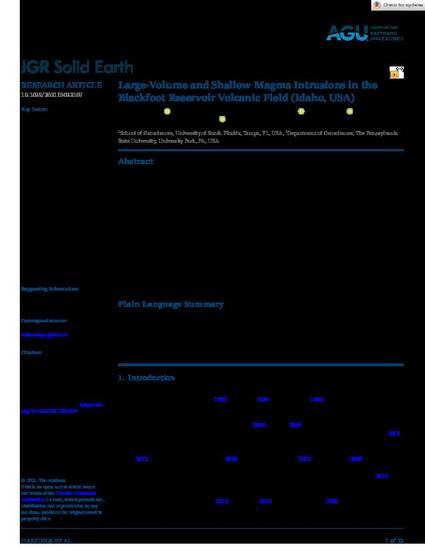
- gravity,
- volcanic field,
- inversion,
- volcanotectonic,
- Basin and Range,
- silicic eruptions
he Blackfoot Reservoir volcanic field (BRVF), Idaho, USA, is a bimodal volcanic field that has hosted silicic eruptions during at least two episodes, as recently as 58 ka. Using newly collected ground and boat-based gravity data, two large negative anomalies (-16 mGal) are modeled as shallow (< 1 km) intrusions beneath a NE-trending alignment of BRVF rhyolite domes and tuff rings. Given the trade-off between density contrast and model volume, best-fit gravity inversion models yield a total intrusion volume of 50-120 km3; a density contrast of -400 kg m-3 results in two intrusions, each ~9 km x 4.5 km and about 0.5 km thick, with cumulative volume of 100 km3. A network of 340°-360° trending faults lies directly above and on the margins of the mapped gravity anomalies. Most of these faults have 5-10 m throw; one has throw up to ~50 m. We suggest that the emplacement of shallow sill-like intrusions produced this fault zone and also created a ENE-trending fault set, indicating widespread ground deformation during intrusion emplacement. The intrusions and silicic domes are located 3-5 km E of a regional, 20 mGal step in gravity. We interpret this step in gravity as thickening of the Upper Precambrian to lowermost Cambrian quartzites in the Meade thrust sheet, part of the Idaho-Wyoming Thrust Belt. Silicic volcanism in the BRVF is a classic example of volcanotectonic interaction, influenced by regional structure and creating widespread deformation. We suggest volcanic hazard assessments should consider the possibility of large-volume silicic eruptions in the future.
Journal of Geophysical Research: Solid Earth, v. 126, issue 11, art. e2021JB022507
Available at: http://works.bepress.com/paul_wetmore/34/
